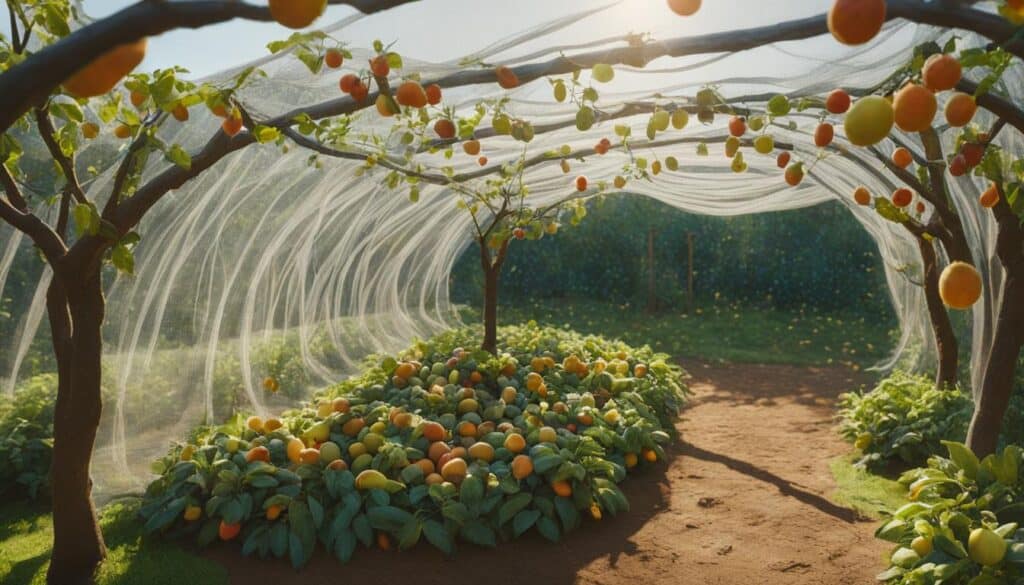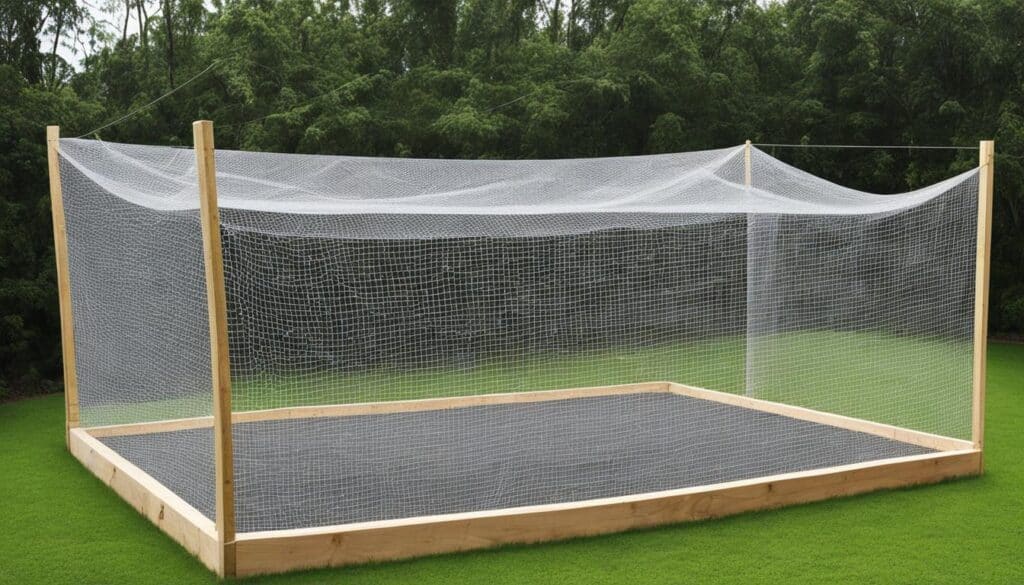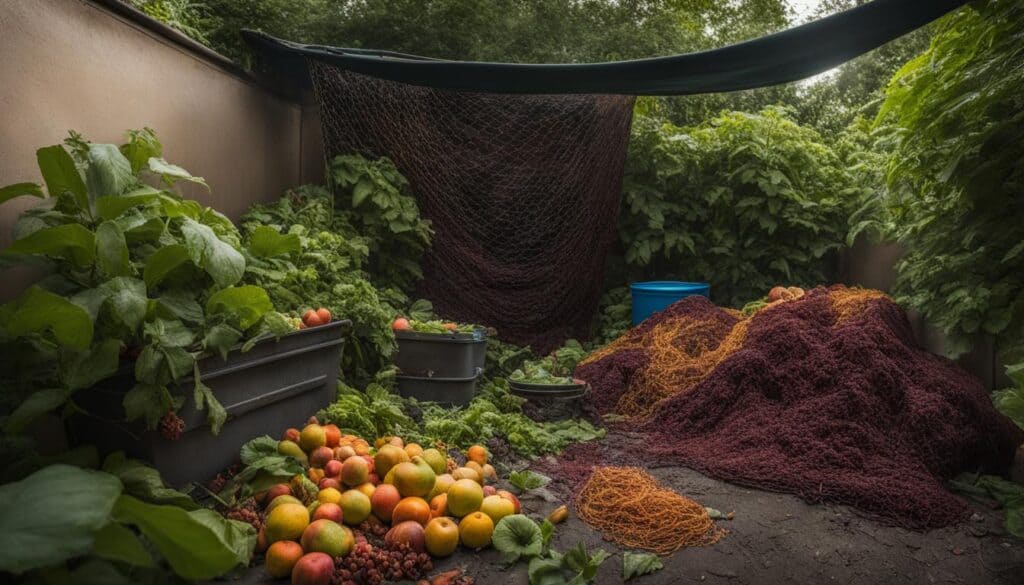As a gardener, there’s nothing quite like the satisfaction of plucking a ripe, juicy fruit from your own tree or bush. However, the joy can quickly turn to disappointment when wildlife and pests decide to help themselves to your hard-earned harvest. This is where fruit tree netting comes to the rescue.
Fruit tree netting is a popular and effective method for protecting your precious fruits from unwanted visitors. With a wide range of netting options available, you can choose the best fruit tree netting that suits your specific needs and the type of pests you want to keep at bay.
Key Takeaways:
- Netting is a proven method for protecting fruit trees from wildlife and pests.
- Choose the right netting method for your specific needs, such as permanent orchard netting, drape netting, garden fabric, bagging, open tunnel, or DIY frame netting.
- Consider wildlife safety, proper installation, and regular maintenance when using netting.
- Permanent orchard netting provides complete protection but may be expensive for home gardeners.
- Drape netting is easy to use and effective for smaller trees or plants.
Permanent Orchard Netting
When it comes to protecting fruit trees, permanent orchard netting is a top choice for commercial orchards. This method involves creating a sturdy structural frame and covering the entire growing area with durable netting. With permanent orchard netting, you can ensure complete protection against wildlife and pests, resulting in a bountiful harvest.
Although highly effective, it’s important to note that permanent orchard netting may not be practical for home gardeners with a smaller number of fruit trees. The cost of installation and maintenance can be significant, making it more suitable for larger-scale operations. However, if you have a commercial orchard or a substantial number of fruit trees, permanent orchard netting is a long-term solution that provides outstanding protection.
To give you a better understanding of the benefits and considerations of permanent orchard netting, I’ve compiled a table summarizing its key features:
| Feature | Benefits |
|---|---|
| Complete Protection | Prevents wildlife and pests from accessing fruit trees |
| Durability | Designed to withstand long-term use and exposure to the elements |
| Scalability | Ideal for large orchards with extensive fruit tree coverage |
| Longevity | Provides ongoing protection season after season |
| Significant Investment | The cost of installation and maintenance may be prohibitive for smaller-scale operations |
Permanent orchard netting offers a robust solution for fruit tree protection, but it’s essential to consider your specific needs and budget before deciding on this method. For home gardeners or those with a smaller number of fruit trees, alternative options like drape netting or DIY frame netting may provide more practical and cost-effective solutions. Stay tuned for the next section on drape netting, where we’ll explore another popular method to safeguard your fruit trees.
Drape Netting
Drape netting is a popular and easy-to-use method of protecting fruit trees. It involves loosely draping a net over the tree or plant without the need for a structure. Drape netting is especially effective for smaller trees or plants and can provide protection for as long as necessary.
When using drape netting, it is important to be mindful of the loose hang of the net. This can increase the risk of tangling and potentially harming wildlife. To ensure the effectiveness of the netting, proper installation and regular maintenance are essential.
Here are some tips for installing and maintaining drape netting:
- Choose a sturdy netting material that is durable and resistant to tearing.
- Measure the size of the tree or plant to determine the appropriate size of the netting.
- Place the netting over the tree or plant, ensuring that it covers all the branches and fruits.
- Tightly secure the netting at the base of the tree or plant to prevent pests from entering.
- Regularly inspect the netting for any damage or gaps and repair or replace as needed.
- During harvest, gently lift the netting to access the fruits and then carefully replace it.
Proper installation and maintenance of drape netting can help protect your fruit trees from pests and ensure a successful harvest.
| Drape Netting Pros | Drape Netting Cons |
|---|---|
| Easy to install | Potential risk of tangling and harming wildlife |
| Effective for smaller trees or plants | May not be suitable for larger trees or plants |
| Provides protection for as long as necessary | Regular maintenance is required to ensure effectiveness |
Garden Fabric
Garden fabric is a versatile and lightweight cloth-like material that serves as an effective solution for protecting fruit trees from pests and insects. It can be used by draping it directly over rows of vegetables or by incorporating it into frames to create a barrier. With its fine mesh structure, garden fabric provides reliable defense against a wide range of pests, including birds and insects, ensuring the health and productivity of fruit trees. Selecting the appropriate mesh size is crucial to prevent smaller pests from infiltrating the protected area.
In addition to shielding fruit trees from pests, garden fabric plays a vital role in promoting successful pollination. Certain fruit trees rely on pollinators, such as bees, to transfer pollen from one flower to another, enabling fruit production. By using garden fabric, you can safeguard the delicate blossoms and ensure that the pollination process proceeds undisturbed, leading to a bountiful harvest.
When using garden fabric, it is essential to adopt proper installation techniques to maximize its effectiveness. Securely fasten the fabric around the tree or frame, ensuring a tight fit that leaves no gaps for pests to exploit. Regular maintenance is also critical to address any wear and tear, as well as to guarantee the fabric’s continued protection.
The Benefits of Garden Fabric
Garden fabric offers a plethora of benefits for fruit tree protection:
- Effective pest control: Garden fabric serves as an effective barrier against birds, insects, and other pests, preventing them from accessing the fruit trees.
- Promotes pollination: By guarding the blossoms from pests, garden fabric facilitates successful pollination, leading to improved fruit set and yields.
- Lightweight and breathable: The lightweight nature of garden fabric allows for adequate air circulation, promoting a healthy environment for fruit trees.
- Versatile usage: Garden fabric can be used not only for fruit trees but also for protecting rows of vegetables, ensuring the overall health and success of your garden.
- UV protection: Some garden fabrics are designed to provide UV protection, shielding fruit trees from the potential harm caused by excessive exposure to sunlight.
It’s important to note that garden fabric is typically not a one-size-fits-all solution. Different fruit tree species may require specific considerations and customized approaches to ensure optimal protection. Consulting with experts or referring to comprehensive gardening resources can assist you in selecting the most suitable garden fabric for your specific fruit tree needs.
A Comparison of Garden Fabric and Other Fruit Tree Netting Methods
| Garden Fabric | Permanent Orchard Netting | Drape Netting | Bagging | Open Tunnel | DIY Frame Netting Total Exclusion |
|---|---|---|---|---|---|
| Provides protection against a wide range of pests and insects | Offers complete coverage for large-scale orchards | Easy to install and suitable for smaller trees | Protects individual fruits from pests | Allows easy access for gardeners while keeping birds away | Cost-effective and customizable |
| Requires proper mesh size selection to prevent smaller pests from entering | Expensive and may not be practical for home gardeners | Needs careful installation to avoid tangling or damaging wildlife | Time-consuming and not suitable for large quantities of fruit | Requires regular maintenance and inspections | Regular maintenance and inspections are essential for effectiveness |
Note: The table above compares garden fabric with other fruit tree netting methods in terms of their unique features and suitability for different scenarios. Choose the netting method that aligns with your specific fruit tree protection requirements.
Bagging
Bagging is a practical method of safeguarding individual fruits by covering them with mesh bags. This technique is commonly employed for smaller fruits and proves effective in preventing damage caused by pests. While bagging can be time-consuming, it is especially suitable for protecting a limited quantity of fruit on a single tree. The key to success lies in securely fastening the bags to prevent pests from entering. Regular inspection and removal of bags are necessary to harvest the fruit at the right time.

Bagging Tips:
- Ensure the bags are large enough to accommodate the fruit and allow for growth.
- Use mesh bags that are specifically designed for fruit protection to allow air circulation and prevent rotting.
- Securely tie the bags at the top, ensuring they are tightly sealed without causing damage to the fruit.
- Inspect the bags regularly for any signs of pests or damage and promptly remove and replace them.
- Consider using reusable mesh bags to reduce waste and environmental impact.
Bagging offers targeted protection for individual fruits, ensuring they remain untouched by pests. While it may require more effort, the rewards of enjoying undamaged, homegrown fruit make it a worthwhile endeavor.
Open Tunnel
In addition to other fruit tree netting solutions, another effective method for protecting garden beds or trellises that require regular access is the open tunnel technique. By creating a structure resembling a tunnel and placing netting over it, gardeners can deter animals from entering the protected area while still allowing easy access for themselves.
An open tunnel is particularly useful for keeping birds away from fruit trees. The netting acts as a barrier, preventing these winged intruders from reaching the fruits while allowing sunlight and air to circulate freely. This method not only protects the harvest but also ensures the overall health and vitality of the fruit tree.
Proper installation and regular maintenance are essential to ensure the netting remains intact and effective. The netting should be secured firmly to the frame, ensuring there are no gaps or tears that animals can exploit. Regular inspections should be carried out to identify any signs of damage or wear and tear, allowing for prompt repairs or replacements if needed.

DIY Frame Netting Total Exclusion
When it comes to protecting fruit trees, DIY frame netting offers an affordable and customizable solution. By creating a temporary frame using materials such as steel, PVC, or wood, you can easily hold the netting off the tree or garden. This method provides complete exclusion of pests and wildlife, ensuring your harvest remains untouched.
DIY frame netting is a popular choice among home gardeners due to its flexibility and cost-effectiveness. It allows you to customize the size and shape of the frame to fit your specific needs. Plus, it can be easily installed and removed as needed, making it convenient for seasonal use.
Regular maintenance and inspections are crucial to ensure the integrity of the netting. Check for any tears or holes in the net and repair them promptly to maintain the effectiveness of the barrier. It’s also important to monitor the frame to ensure it remains stable and secure.
If you’re unsure how to get started with DIY frame netting, there are plenty of resources available online that provide step-by-step installation guides. These guides can offer valuable insights and tips to help you set up your fruit tree netting successfully.
Remember, the goal of DIY frame netting is to provide a total exclusion for pests and wildlife while allowing your fruit trees to thrive. By investing a little time and effort in the installation and maintenance of your netting, you can enjoy a bountiful harvest free from unwanted visitors.

Image Caption: DIY frame netting provides complete exclusion of pests and wildlife, protecting your fruit trees.
10 Things to Consider When Using Netting
When it comes to protecting fruit trees with netting, it’s important to keep a few key factors in mind. To ensure the safety of wildlife, it’s crucial to prevent animals from getting tangled in the netting. Erecting the netting at the appropriate time after pollination is essential for optimal fruit development. Allowing adequate clearance for tree growth will prevent the netting from constricting the branches. And when the season comes to an end, proper removal of the netting ensures it doesn’t cause any damage.
Here are ten things to consider when using netting:
- Wildlife Safety: Prevent animals from getting tangled in the netting
- Timing: Erect netting at the right time after pollination
- Clearance: Allow enough space for tree growth
- Proper Removal: Ensure the netting is removed correctly at the end of the season
- Reuse: Consider reusing netting for multiple seasons
- UV Protection: Choose netting with UV protection to increase durability
- Easy Entry: Provide easy access points for harvesting fruits
- Wind Gusts: Secure netting to withstand strong winds
- Color Choice: Decide between white or black netting based on specific needs
- Netting Necessity: Use netting only when necessary to minimize labor and cost
By taking these considerations into account, you can ensure the effective and efficient use of netting to protect your fruit trees. Remember, proper installation and regular maintenance are key to the success of your netting strategy.
| Consideration | Description |
|---|---|
| Wildlife Safety | Prevent animals from getting tangled in the netting |
| Timing | Erect netting at the right time after pollination |
| Clearance | Allow enough space for tree growth |
| Proper Removal | Ensure the netting is removed correctly at the end of the season |
| Reuse | Consider reusing netting for multiple seasons |
| UV Protection | Choose netting with UV protection to increase durability |
| Easy Entry | Provide easy access points for harvesting fruits |
| Wind Gusts | Secure netting to withstand strong winds |
| Color Choice | Decide between white or black netting based on specific needs |
| Netting Necessity | Use netting only when necessary to minimize labor and cost |
Security and Disposal of Netting
Ensuring the security of fruit tree netting is essential to protect against damage caused by wind gusts and storms. By securely anchoring the frame to the ground, gardeners can fortify the netting and ensure its effectiveness even in adverse weather conditions.
When it comes to the disposal of netting, proper handling is crucial to prevent harm to wildlife. Discarded netting can pose a threat to animals if not disposed of responsibly. Following recommended disposal methods and practices is vital to maintain a wildlife-friendly environment.
One environmentally conscious method is burying the netting deep in the ground, away from burrowing animals. This helps prevent wildlife from getting entangled or injured by the discarded netting. By burying it, gardeners can minimize the risks associated with improper netting disposal.
Moreover, considering alternatives to plastic netting can further reduce the environmental impact. With innovative options such as biodegradable or wildlife-friendly netting, gardeners can ensure their netting choices align with sustainable practices.
By prioritizing the security and responsible disposal of netting, gardeners can protect their fruit trees while minimizing harm to wildlife and promoting a greener approach to gardening.

Conclusion
Protecting your fruit trees from pests and wildlife is essential for a successful and bountiful harvest. Fortunately, netting offers an effective and humane solution to safeguard your precious fruit. By selecting the right netting method that suits the specific needs of your trees and keeps out the pests, you can enjoy the fruits of your labor.
Proper installation and regular maintenance are key to maximizing the effectiveness of fruit tree netting. Ensure the netting is securely fastened and check for any damage or gaps that could allow pests to enter. It’s also important to consider the safety of wildlife by preventing animals from getting tangled in the netting.
With creative fruit tree netting ideas such as permanent orchard netting, drape netting, garden fabric, bagging, open tunnel, and DIY frame netting, there are solutions available for every garden size and budget. Choose the option that best suits your needs and follow the proper installation and maintenance guidelines to secure your harvest.
So, whether you’re a beginner or an experienced gardener, incorporating fruit tree netting into your gardening routine can help protect your precious fruits and ensure a successful harvest year after year. With careful planning and implementation, fruit tree netting can be a valuable tool in your gardening arsenal.
FAQ
What are some creative fruit tree netting ideas to protect my harvest?
There are several creative fruit tree netting ideas you can try to protect your harvest. Some effective options include permanent orchard netting, drape netting, garden fabric, bagging, open tunnel, and DIY frame netting.
What is permanent orchard netting and how does it work?
Permanent orchard netting is a highly effective method for protecting fruit trees. It involves covering the entire growing area with a permanent structural frame and net. This method provides complete protection against wildlife and pests, ensuring a bountiful harvest.
How does drape netting work and when should I use it?
Drape netting is a popular and easy-to-use method of protecting fruit trees. It involves loosely draping a net over the tree or plant without the need for a structure. Drape netting is especially effective for smaller trees or plants and can provide protection for as long as necessary.
What is garden fabric and how can it protect my fruit trees?
Garden fabric is a lightweight cloth-like material that can be used to protect fruit trees from pests and insects. It can be draped over rows of vegetables directly or used with frames to create a barrier. Garden fabric is versatile and can provide protection against a wide range of pests, including birds and insects.
How does bagging work as a fruit tree protection method?
Bagging is a method of protecting individual fruits by covering them with bags made of mesh material. This method is commonly used for smaller fruits and can be effective in preventing damage from pests. However, it is important to ensure the bags are securely fastened to prevent pests from entering.
What is an open tunnel and how can it protect my fruit trees?
An open tunnel is a method of protecting garden beds or trellises that require regular access. It involves placing netting over a frame that is open at each end, resembling a tunnel. Open tunnels can deter animals from entering the protected area while still allowing easy access for gardeners.
How does DIY frame netting work and how can I install it?
DIY frame netting is a cost-effective and customizable method of protecting fruit trees. It involves creating a temporary frame to hold the net off the tree or garden. Frames can be made from various materials, such as steel, PVC, or wood. Netting is then secured to the frame, providing complete exclusion of pests and wildlife.
What are some important things to consider when using netting for fruit tree protection?
When using netting to protect fruit trees, it is important to consider wildlife safety, proper installation, regular maintenance, UV protection, reusing netting, providing easy entry points for harvest, choosing between white or black netting, and using netting only when necessary.
How can I ensure the security and proper disposal of fruit tree netting?
Ensuring the security of fruit tree netting is essential to prevent damage from wind gusts and storms. The frame should be securely anchored to the ground. When disposing of netting, it is important to handle it with care, as discarded netting can be dangerous to wildlife. Proper disposal methods, such as burying the netting deep and away from burrowing animals, should be followed.





Leave a Reply